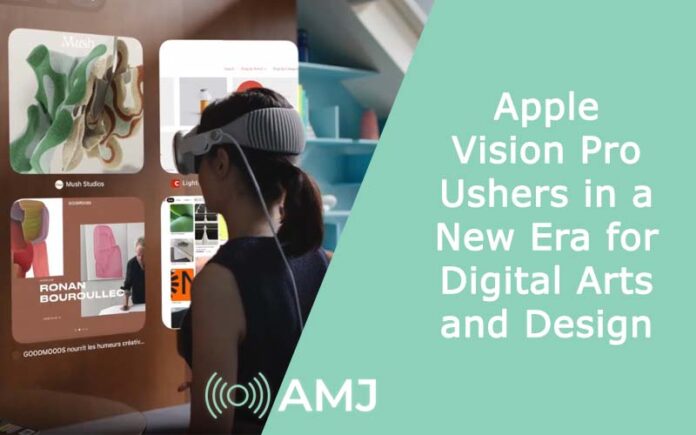Apple’s latest innovation, the Apple Vision Pro augmented reality headset, launched on February 2, 2024, in the U.S., promises to redefine our interaction with the digital and real world. This groundbreaking device is particularly significant for digital design agency Fivecube looking to push the boundaries of creativity and innovation.
The impact of Apple Vision Pro extends beyond everyday life, heralding a transformative phase in the digital arts and design sector. For digital design agencies, this new tool is set to revolutionize design workflows and introduce fresh creative processes, enabling them to deliver unparalleled digital experiences to their clients.
Contents
Overview of Apple Vision Pro
Marketed as a spatial computer, the Apple Vision Pro is a mixed-reality headset that overlays virtual elements, such as web browser windows, onto the real world in three dimensions. With a price tag of $3,500, it leverages cameras to blend the digital with the physical, supported by real-time environmental analysis for placing virtual objects on actual surfaces.
Interaction with these virtual elements is facilitated through eye tracking, hand gestures, and voice commands. Additionally, the EyeSight feature ensures users’ eyes are visible to others while wearing the headset.
Operating on the newly introduced visionOS, developers received access to its software development kit (SDK) in June 2023. The visionOS SDK integrates well-known technologies, enabling the creation of immersive 3D interfaces through tools like Xcode, SwiftUI, RealityKit, ARKit, and TestFlight. Developers interested in creating visionOS applications can utilize the Apple Vision Pro developer kit for testing and consultation.
Among the 600+ apps for visionOS, several digital design applications are emerging as essential tools for designers.
Benefits for Designers Utilizing Apple Vision Pro
Designers across various domains, from SaaS website design to mobile game development, can leverage Apple Vision Pro’s capabilities to enhance digital graphic design processes. Notable apps on visionOS include:
- Da Vinci Eye: A digital art projector that facilitates the tracing of real-world objects onto a digital canvas and superimposing digital illustrations onto physical items.
- LiveSurface: A tool for visualizing designs on real-world objects in real-time, enhancing presentation and conceptualization.
- Bento|Craft: A versatile design tool offering pre-made layouts and templates for app developers and marketers, available on both iPad and visionOS.
The Potential Impact on Digital Art and Design
The widespread adoption and affordability of Apple Vision Pro are pivotal for its potential to redefine digital graphic design. It promises to introduce new design systems and conventions suited for 3D space, along with transforming design workflows by enabling real-world previews of digital works, thus reducing the need for costly prototypes.
Furthermore, the headset supports spatial productivity applications that could revolutionize design tasks and collaborative work through its 360-degree workspace, with popular tools like Microsoft 365 apps and Zoom already available on visionOS.
Four Transformative Aspects of Apple Vision Pro
- Design Previewing: Tools like LiveSurface allow for real-world previews of digital designs, streamlining the design process.
- Reference Utilization: The ability to use real objects as references directly within a digital canvas opens up new creative possibilities.
- Infinite Canvas: The spatial computing capabilities eliminate the need for multi-screen setups, offering an expansive 360-degree workspace.
- Demand for AR Designs: The unique features of Apple Vision Pro are likely to spur demand for AR and 3D interface designers, expanding the scope of digital design.
Conclusion
Although the array of digital design applications for Apple Vision Pro is currently more limited compared to platforms like Windows or macOS, its introduction marks a significant advancement in design technology. The future of this technology’s adoption and its impact on the design industry remains to be seen, largely dependent on its affordability. For the latest in design technology and best practices, keep an eye on updates from leading design blogs.












![Index of Money Heist [Season 1, 2, 3 & 4 – All Episodes, Cast and Plot] Index of Money Heist](https://www.asiamediajournal.com/wp-content/uploads/2021/05/Index-of-Money-Heist-3-100x70.jpg)